How the Haflinger came to Ebbs ...

Land & Leute
How the Haflinger came to Ebbs ...
First of all, I wanted to know to which diocese the church was attributed to and who built it?
This takes me back to the early Middle Ages when the diocesan borders were drawn in 739. For this purpose, the Ziller river of the Zillertal valley served as a border: the land east of the Ziller river and south of the Inn river were assigned to the Archdiocese of Salzburg, the land west was assigned the diocese of Bressanone (today Italy). This demarcation is also the reason for the red and green church towers. The towers belonging to the Archdiocese of Salzburg shine in noble green because of the copper tiles. The tower roofs of the former "Bressanone side" are covered with simple red bricks. Salzburg simply had more money and copper stood for wealth!

Back to Ebbs: In the 8th century Ebbs was part of Bavaria and ruled by a duke. Ebbs was ruled by the rich and powerful noble family of the “Aribonen”. This large family donated many monasteries and churches, including the one in Ebbs. Later on, land and church were given to the diocese of Salzburg. Ebbs was first mentioned in 788 in the so-called "Notitia Arnonis", a list of possessions belonging to the diocese of Salzburg.
The Ebbs chronicles also state that the Ebbs church was the parent church for the villages of Kufstein, Niederndorf, and Walchsee for almost 1000 years before they became independent parish churches from the end of the 18th century. The affiliation of these three churches to their parent parish church Ebbs entailed all sorts of obligations.
The dependency of the local churches on their parent church was only slowly eased. Above all, the number of public holidays on which all residents had to attend the service in Ebbs was reduced. According to the chronicles the Christmas Midnight Mass wouldn’t start until the farmer “Gründler” from Walchsee, who lived the furthest away, had gathered with a cheese loaf in the sacristy.
As the example of the noble family “Aribonen” shows, in the Middle Ages it was standard for wealthy people to donate various things to the church: from candles to altars, to chapels or the salaries for priests and sacristans. Such donations were also made to become independent from the parent church. The community of Niederndorf was the first to withdraw from Ebbs in 1786. This is probably due to their petition to the Archdiocese because they were not able to provide enough donations. So we could read in the history books: The priest comes - especially in rainy weather - too late or the people of Niederndorf would have to stand in the Ebbs church, since the chairs were reserved for their own people ... Their list of claims continued even further.
Let's go back to the Middle Ages: There are hardly any architectural structures left from the early medieval wooden church. However, there are still remains of a stone-built building erected in the 12th century.

Later, the church was rebuilt in Gothic style, as shown in a painting hanging in the Saint Nicholas church. It was donated by the couple Simon Laimbinger and Anna Hellin, kneeling in the foreground, asking the Holy Mother and Saint Nicholas for help against the flooding. The two houses in the background are the former Postwirt hotel on the left and the Schusterhäusl (today: Ankerhaus) on the right.
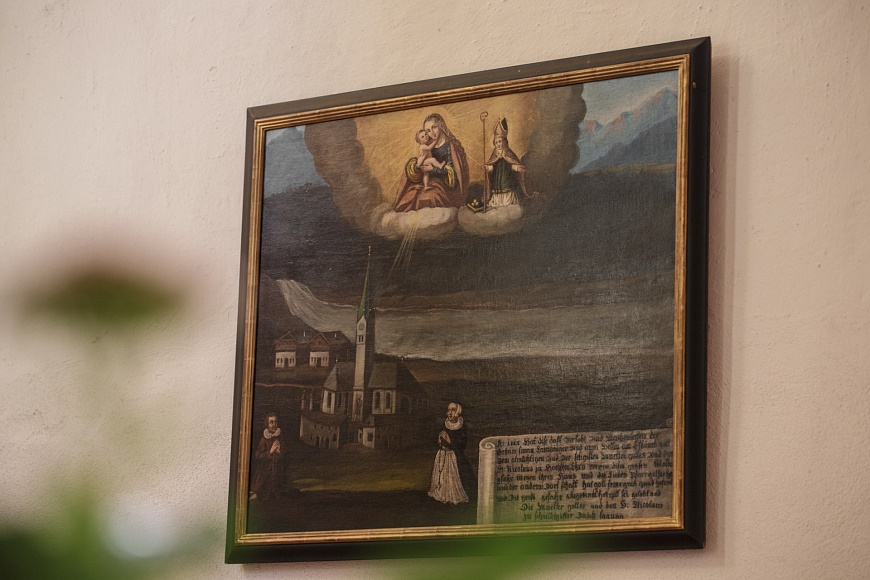
Like many Tyrolean churches the parish church Ebbs was redesigned in the Baroque style in the mid-18th century. For this purpose, the Gothic church was completely demolished except for parts of the tower. The Bavarian Abraham Millauer, "Master Abraham", as he was called, was the builder. Approximately 9,000 guilders were budgeted for the construction of the new church. But after completion, the total amounted to 32,000! Exceeding the budget is not just a phenomenon of today …
According to a legend, the builder had miscalculated the costs due to the size of the church. When running out of stones in the middle of construction, he prayed to God for help. That same night a rockfall from the Zahmer Kaiser mountains thundered into the valley, thus providing the building material “free of charge”.
As sober and simple the church looks like from the outside, as colorful is the inside. Particularly noteworthy are the ceiling frescos by Josef Adam Mölk. Those in the central aisle mainly show scenes from the life of the Holy Mary. Also, the main altar with the image of Our Lady of Ebbs in the middle is marvelous. The Gothic wooden statue of Madonna and Child probably dates back to the 15th century.
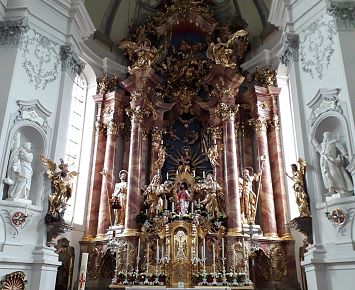 Main AltarZoom
Main AltarZoom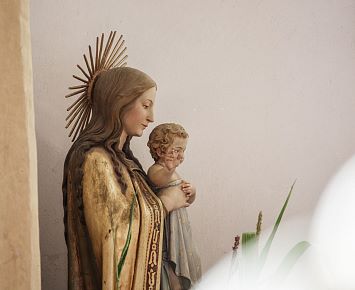 Gothic wooden statue of Madonna and ChildZoom
Gothic wooden statue of Madonna and ChildZoom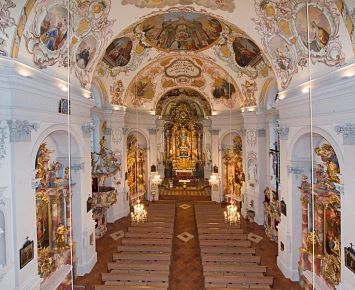 The richly decorated interior of the churchZoom
The richly decorated interior of the churchZoomA fresco above the organ gallery shows the Baroque church and the river Inn which - at that time - led past the cemetery wall. The Inn was not only an important traffic route, but also dangerous. That’s why you find many statues of the Bohemian Saint John Nepomuk in Ebbs and its surroundings. He is a patron against flooding and also decorates the west facade of the church in Ebbs as well as northern confessional in the inside.
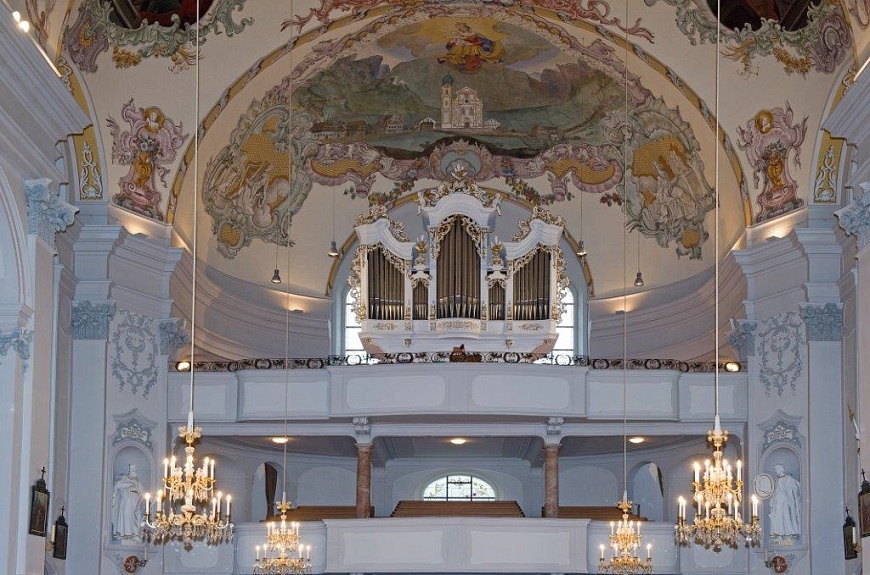
There are several reasons why I highly recommend to visit the Ebbs parish church: The art-minded visitor may admire the interior of this Baroque beauty. The faithful ones may pause, pray, recharge their batteries, and feel like being in the “heavenly Jerusalem", as did the people of the 18th century. And there's something else. Attend a service. This possibility is open to everyone!
After reading this blog, have you also become a passion for churches?
0 Comment (s)
More comments